Disease Introduction
Diabetes Insipidus (DI)
- A metabolic problem connected to antidiuretic hormone (ADH) issues.
- A rare condition (1:25000) (Kalra et al., 2016).
- Symptoms: polyuria (very diluted), thirst, night sweats, fatigue.
- Dangerous for children/infants (symptoms: vomiting, fever, convulsions) (Dabrowski, Kadakia, & Zimmerman, 2016).
- Not connected to diabetes mellitus (does not presuppose hyperglycemia).
DI is a rather rare metabolic concern that has diverse etiology but is technically related to a decrease in the levels of or response to the antidiuretic hormone (ADH), which is the hormone that regulates body fluids (Kalra et al., 2016). DI’s symptoms include excessive and very diluted urine and increased thirst; additional symptoms may be present, especially for particular groups of patients. For instance, children and infants demonstrate very violent symptoms, including vomiting and convulsions (Dabrowski et al., 2016). DI can be differentiated from diabetes mellitus due to the fact that DI patients do not exhibit hyperglycemia.

Risk Factors and Etiology
DI affects people of different age and gender, and its etiology varies depending on its type.
Causes/Etiology
Types (Abbas, Iqbal, Iqbal, Javaid, & Ashraf, 2016; Bockenhauer & Bichet, 2015; Kalra et al., 2016; Robertson, 2016):
- Central – the most common one (pituitary gland/hypothalamus ADH secretion/release issues). Usually acquired.
- Nephrogenic – less common, caused by unresponsiveness to ADH in kidneys. Can be hereditary or acquired.
- Gestational – during pregnancy, caused by cysteine aminopeptidase (a placenta enzyme), which reduces ADH.
- Primary polydipsia – excessive fluid intake can repress ADH production.
Thus, central DI is associated with dysfunction in the organs that secrete and release ADH, including the pituitary gland and hypothalamus. Nephrogenic DI, on the other hand, is related to kidneys failing to respond to ADH. Gestational DI is the type of this disorder that occurs only during pregnancy because of a particular enzyme that affects ADH. Finally, primary polydipsia is an issue that leads to ADH reduction because of excessive fluid intake. In any case, DI is connected to ADH problems.
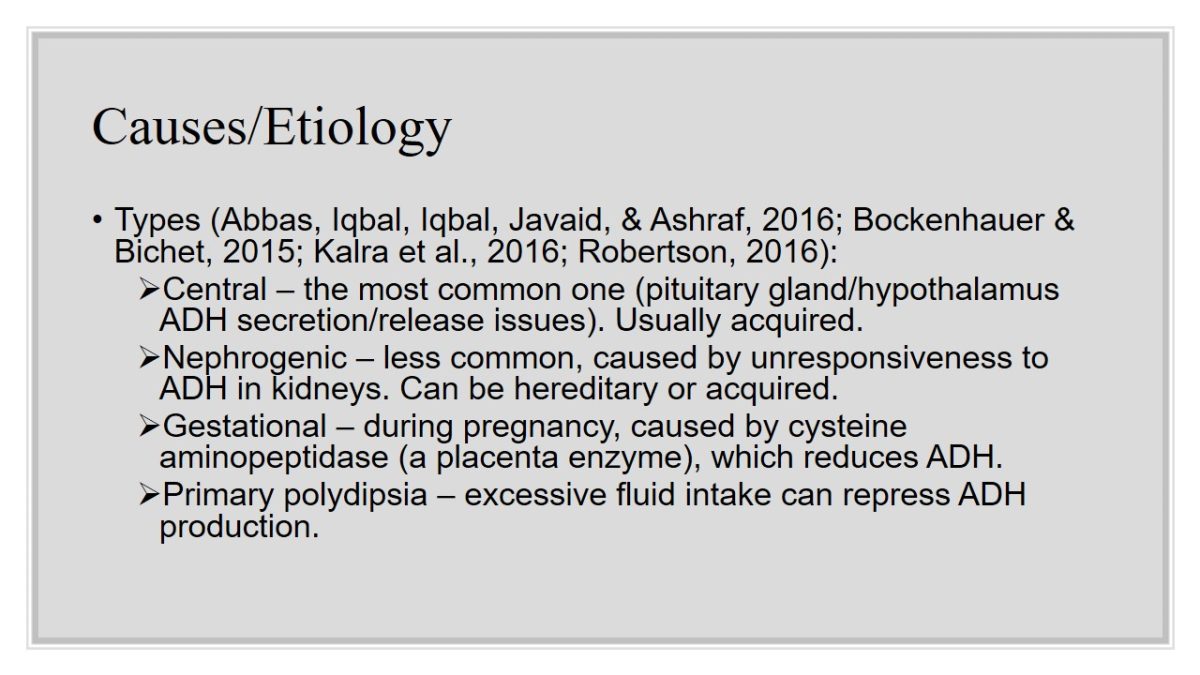
Risk Factors
- Pituitary gland/hypothalamus/kidney damage (Kalra et al., 2016):
- physical damage (e.g., head trauma, tumor, surgery meant to treat a tumor);
- infection/diseases (e.g., meningitis, encephalitis);
- drugs/toxins/radiation; other damaging factors.
- Developmental abnormalities in the gland (esp. in children) (Dabrowski et al., 2016).
- Hereditary factors (Kalra et al., 2016):
- rare (10% of all cases);
- usually kidney response failure (X-linked in males; mutations).
- Primary polydipsia causes (Kalra et al., 2016; Robertson, 2016):
- psychiatric disorders;
- specific drugs (that cause thirst).
Consequently, risk factors differ for different types of DI. The DI that is caused by dysfunction in particular organs is usually associated with damage dealt to those organs, for example, through physical harm or infection. Any exposure to toxins, as well as radiation, can also be risk factors. For instance, a person may have their pituitary gland damaged because of a tumor, but particular treatments for cancer can also become a cause of DI (Kalra et al., 2016). In addition to that, as can be seen from the cases of DI in children, the described organs might have developmental abnormalities resulting in DI (Dabrowski et al., 2016).
Hereditary DI is possible, especially in men since the defects that cause kidneys to fail to respond to ADH are X-linked. However, this problem is relatively rare; most DI cases are not hereditary (Kalra et al., 2016). As for primary polydipsia, it is a problem that is typically caused by psychiatric conditions or specific drugs that can increase thirst (Kalra et al., 2016; Robertson, 2016).
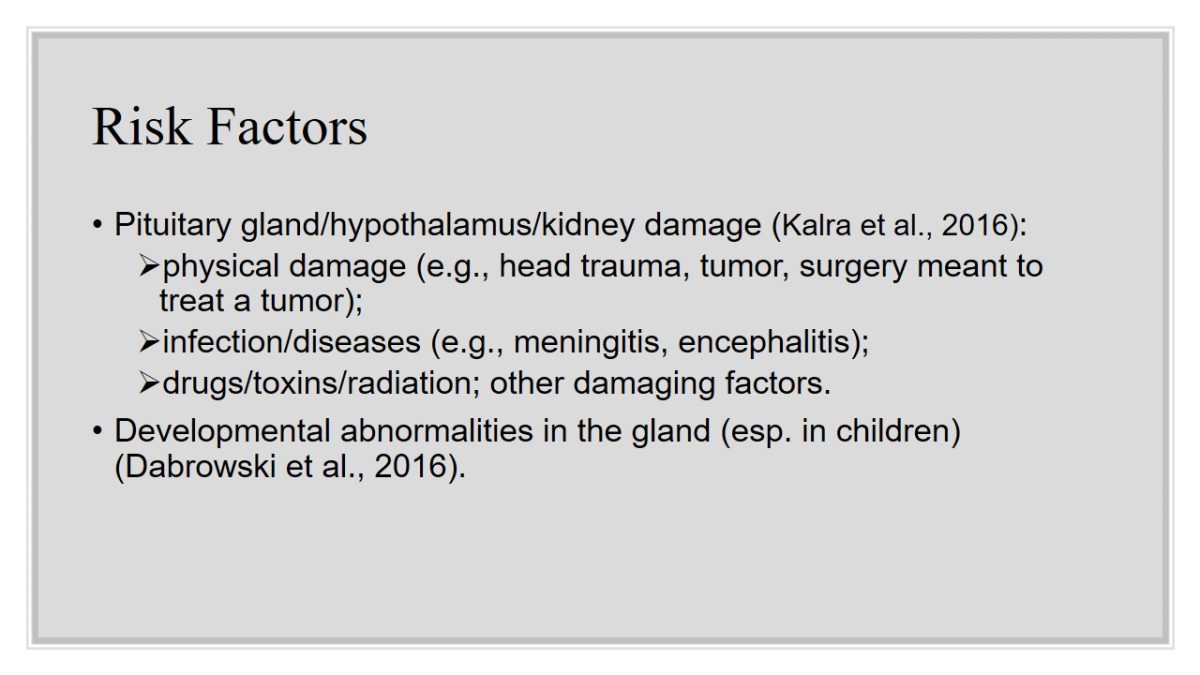
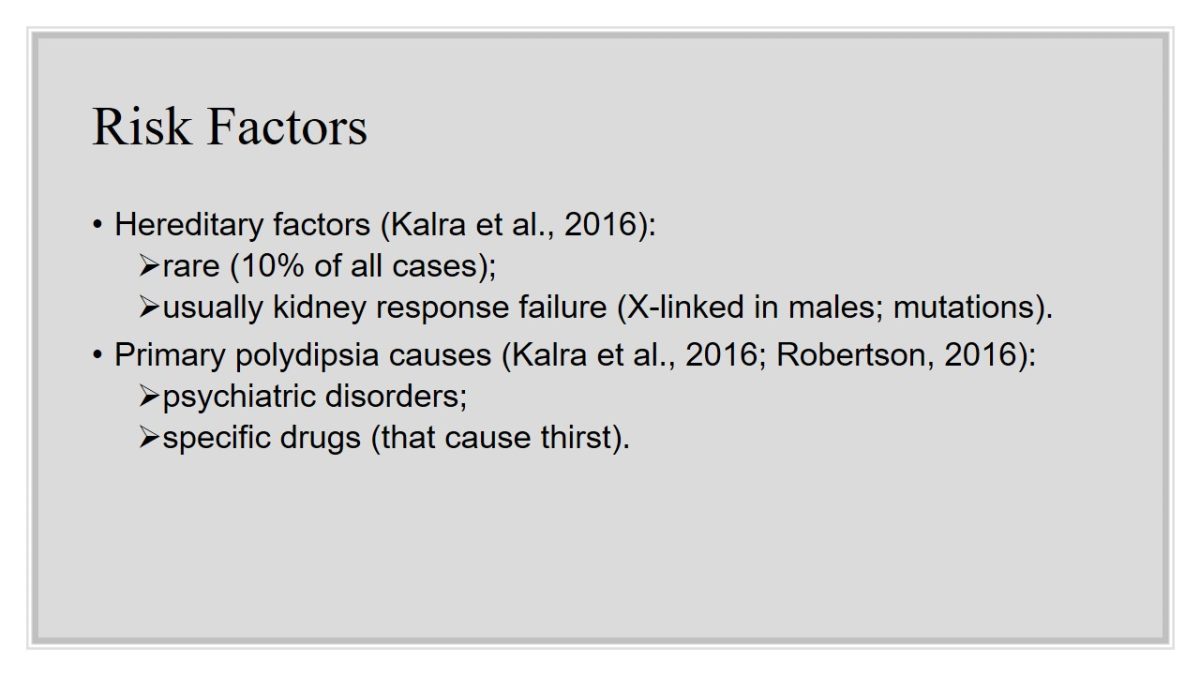
Disease Progression
The disease progression can be summarized as follows.
Disease Progression and Possible Outcomes
Progression according to the recent literature (Abbas et al., 2016; Kalra et al., 2016; Robertson, 2016):
- Initial cause (usually injury/hereditary condition).
- Reduction in ADH/improper reaction of organs to ADH.
- Disruption in the body’s water balance.
- Increased urination.
- Thirst as a defense mechanism.
- If enough hydration: relative balance, osmolality barely increased (Robertson, 2016).
- If not enough hydration: dehydration, fluid disbalance, increased plasma osmolality; becomes life-threatening (up to hypovolemic shock).
- In children: weight loss, growth retardation (Dabrowski et al., 2016).
- High mortality: in people with hydration difficulties (e.g., age, unconsciousness, post-surgery, etc.) (Robertson, 2016).
The initial problem, which is often an injury in an ADH-related organ causes a reduction in ADH or an organ’s inability to respond to it appropriately. The result is a disruption in the body’s water balance, which leads to the common symptoms, including increased urination. From this perspective, the other common symptom (increased thirst) is a defense mechanism; if it functions well with the patient hydrating him- or herself, the fluid balance is mostly maintained (Robertson, 2016). In that case, the disorder is unlikely to have significant negative outcomes and simply requires appropriate management.
However, if a person cannot or does not want to rehydrate, they become dehydrated with the common negative outcomes of the condition, including hypovolemic shock (Cooper & Gosnell, 2019; Robertson, 2016). In addition, in children, the issue results in weight loss and growth retardation (Dabrowski et al., 2016). As a result, DI is predominantly dangerous for the people who fail to hydrate, for instance, infants or people who are unconscious after surgery.
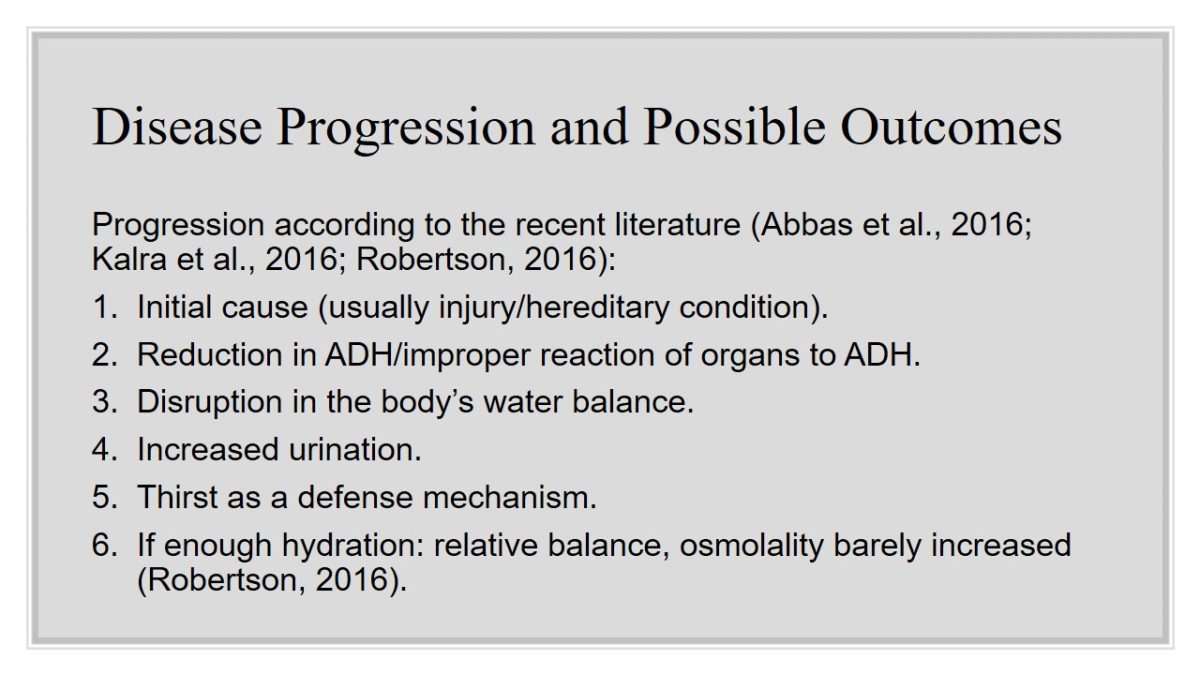
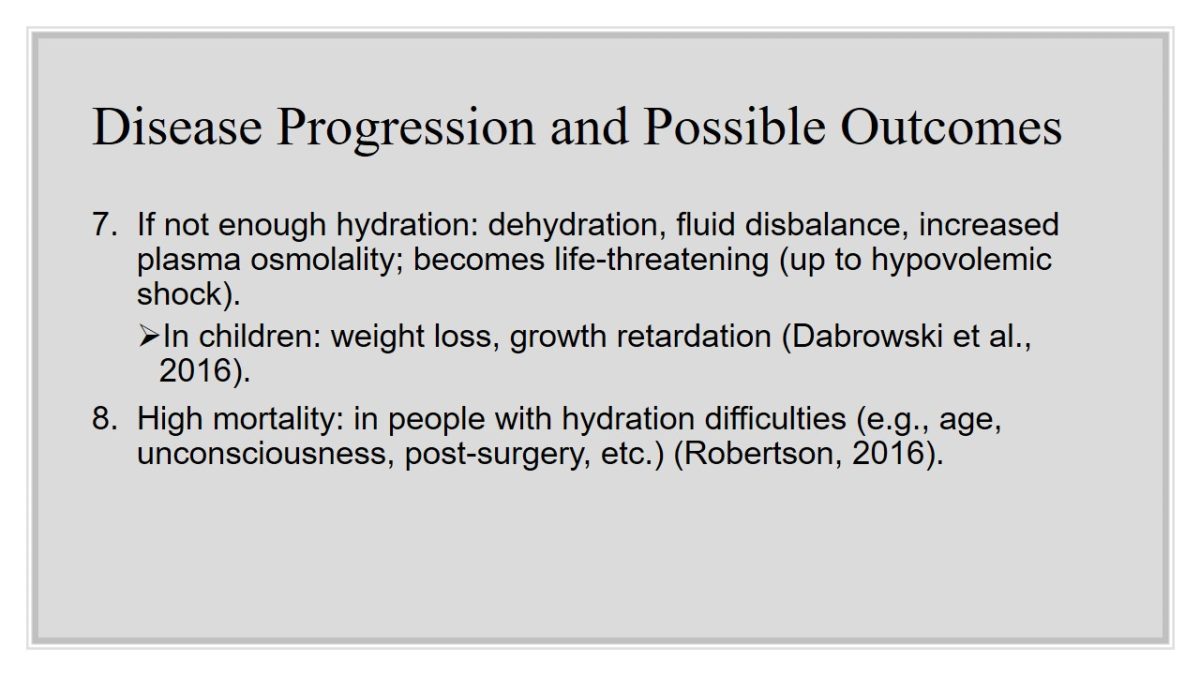
Implications for Practitioners
The presented information is relevant for various groups of healthcare practitioners, including family nurse practitioners.
The Role of Nurse Practitioners
- Secondary prevention: considering risk factors (e.g., head trauma, surgery, brain tumor, etc.) (Cooper & Gosnell, 2019).
- Especially important with patients who cannot self-hydrate.
- Tertiary (Cooper & Gosnell, 2019; Urden, Stacy, & Lough, 2016):
- managing the condition (assessments, monitoring),
- monitoring hydration,
- monitoring complications,
- prevention of negative outcomes (e.g., falls).
While most of the described DI causes cannot be prevented directly, DI can be spotted early and addressed in time. Therefore, the causes and risk factors need to be taken into account as a part of secondary DI prevention; it is especially important for the practitioners who work with the patients who cannot hydrate themselves, for example, because they are recovering after surgery. Furthermore, nurse practitioners need to prevent the potential negative outcomes of the issue by ensuring patients’ hydration, monitoring for the signs of complications, and assisting patients with the tasks that DI makes more difficult (Cooper & Gosnell, 2019; Urden et al., 2016).
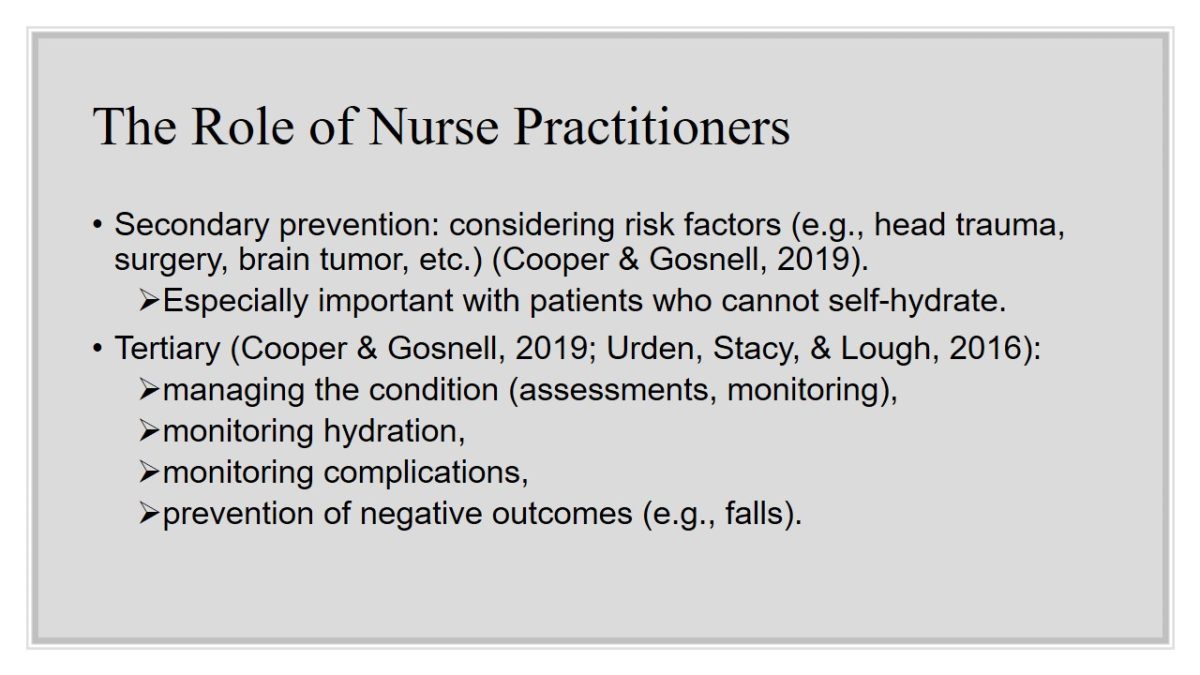
Summary
- Different DI types – different etiologies; multiple risks to consider.
- Common risk factors: injury, surgery, infections; hereditary conditions, pregnancy.
- Symptoms: polyuria, thirst; no hyperglycemia.
- Prevention:
- monitoring high-risk patients,
- detecting DI early,
- ensuring rehabilitation and preventing complications/negative outcomes.
The most common ones are various injuries, surgeries, and infections that can affect the organs that produce or respond to ADH, but DI can also be hereditary or pregnancy-related. The symptoms are mostly connected to excessive urination and thirst, but patients exhibit no hyperglycemia. The three levels of prevention include paying attention to patients who are at a high risk of DI, as well as the related symptoms, and providing the necessary care that would help a person avoid the potential consequences of DI.
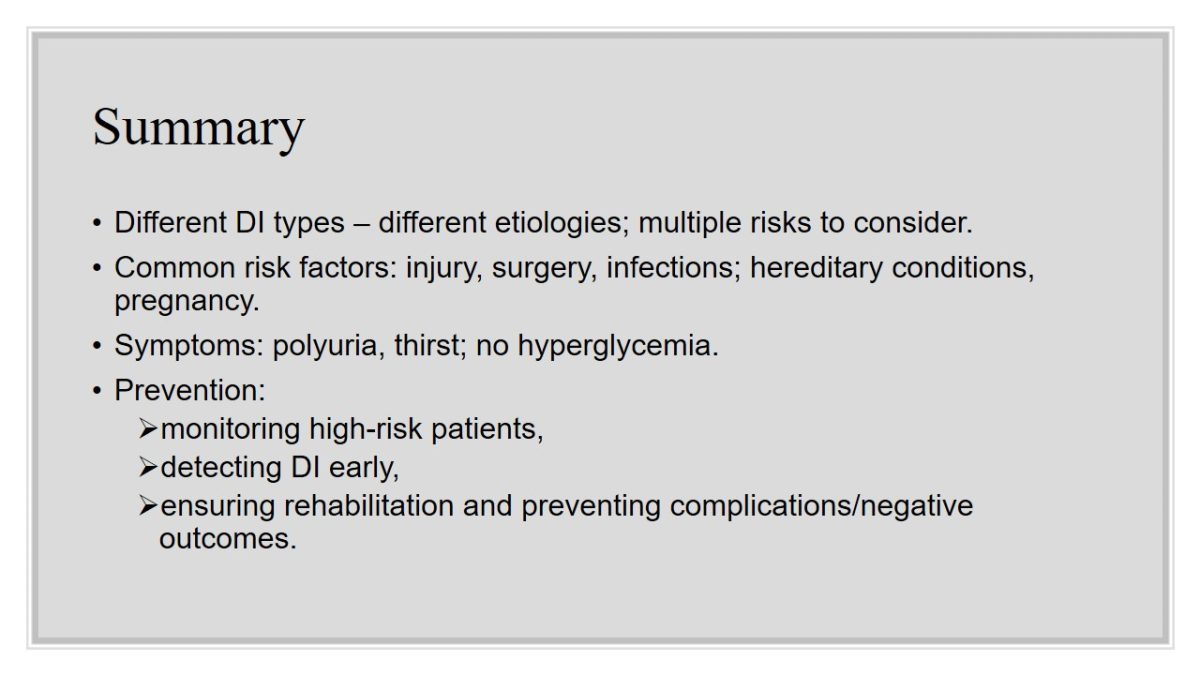
References
Abbas, M., Iqbal, M., Iqbal, M., Javaid, R., & Ashraf, M. (2016). Diabetes insipidus: The basic and clinical review. International Journal of Research in Medical Sciences, 4(1), 5-11. Web.
Bockenhauer, D., & Bichet, D. (2015). Pathophysiology, diagnosis and management of nephrogenic diabetes insipidus. Nature Reviews Nephrology, 11(10), 576-588. Web.
Cooper, K., & Gosnell, K. (2019). Adult health nursing (8th ed.). St. Louis, MO: Elsevier Health Sciences.
Dabrowski, E., Kadakia, R., & Zimmerman, D. (2016). Diabetes insipidus in infants and children. Best Practice & Research Clinical Endocrinology & Metabolism, 30(2), 317-328. Web.
Kalra, S., Zargar, A. H., Jain, S. M., Sethi, B., Chowdhury, S., Singh, A. K., … Malve, H. (2016). Diabetes insipidus: The other diabetes. Indian Journal of Endocrinology and Metabolism, 20(1), 9-21. Web.
Robertson, G. (2016). Diabetes insipidus: Differential diagnosis and management. Best Practice & Research Clinical Endocrinology & Metabolism, 30(2), 205-218. Web.
Urden, L. D., Stacy, K. M., & Lough, M. E. (2016). Priorities in critical care nursing (6th ed.). St. Louis, MO: Elsevier Health Sciences.